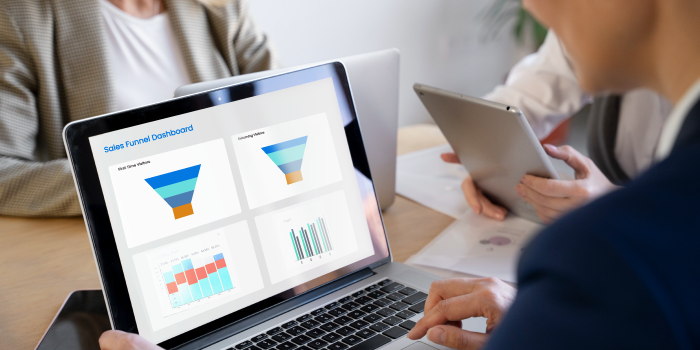Struggling to create a sales funnel that turns leads into high-value customers?
From navigating customer data to implementing nurturing campaigns, setting up a sales funnel requires strategy and intentionality.
Luckily for you, we’re removing the guesswork so you can focus on what works.
Read on to learn what a sales funnel actually is, the four stages that drive it, and how to optimize yours.
What is a sales funnel?
A sales funnel is a series of systems you set up to use as a lead conversion process.
Business owners know that the specific conversion path for each lead varies. But with a sales funnel in place, you can support prospects at every touchpoint throughout their journey.
And the best part?
The right sales funnel can be a win-win for prospective customers and businesses. By setting up a strategic sales funnel, you can help ideal customers solve problems and scale your sales growth.
What are the 4 stages of the sales funnel?
Sales funnels vary depending on the business owner’s target market and sales goals.
But the four stages of the typical sales funnel include the:
- Awareness stage
- Interest stage
- Decision stage
- Action stage
Some marketers refer to this as the “AIDA” model for short.
Whether they’re still learning about you, just heard about you, or are thinking about making a purchase, a funnel guides prospects along the way.
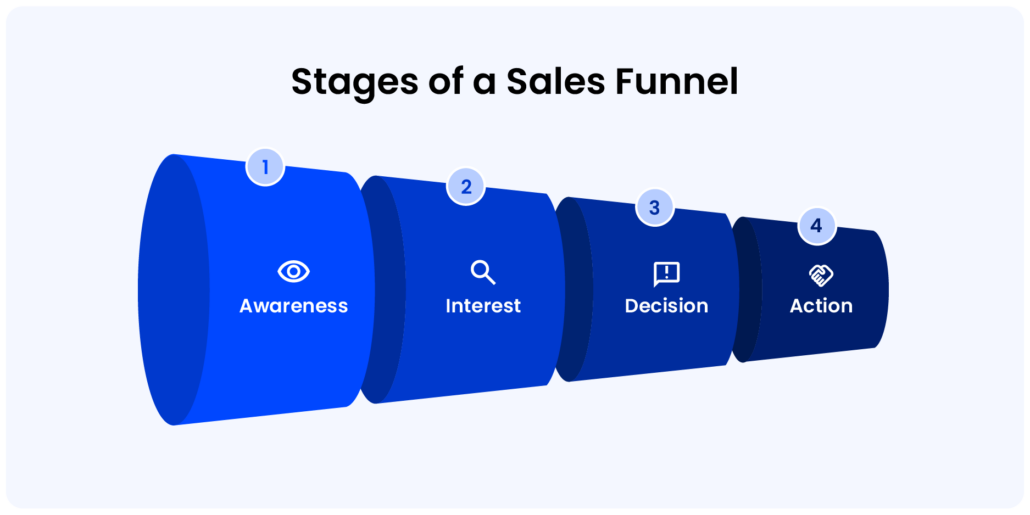
For instance, in the awareness phase, leads are getting to know you. Event invitations, paid ads, and consistent social media content can help them understand who you are and what problems you solve.
Once you’ve gained your leads’ interest, informational blog posts, case studies, and customer reviews can teach them more about your product/service offerings and nurture them toward a purchase decision.
At the decision stage, prospects know how you can help them. But they need to make sure your pricing, plans, and features align with their needs. Discovery calls and personalized demos can guide them to their final decision.
Finally, your prospect has reached the bottom of the funnel, and they’re ready to take action. To remove as much friction as possible, you need to have clear CTAs and a smooth sales process. Anticipating their questions with an FAQ section can overcome the last objections and seal the deal.
With the basics in mind, let’s review how you can improve your sales funnel.
Best practices for sales funnel optimization
Follow these nine steps to optimize your sales funnel.
1. Audit your current funnel
Start by understanding where your current funnel falls short and pivot accordingly.
Our advice?
Use analytics to uncover weak points in your sales funnel and pinpoint what’s working well.
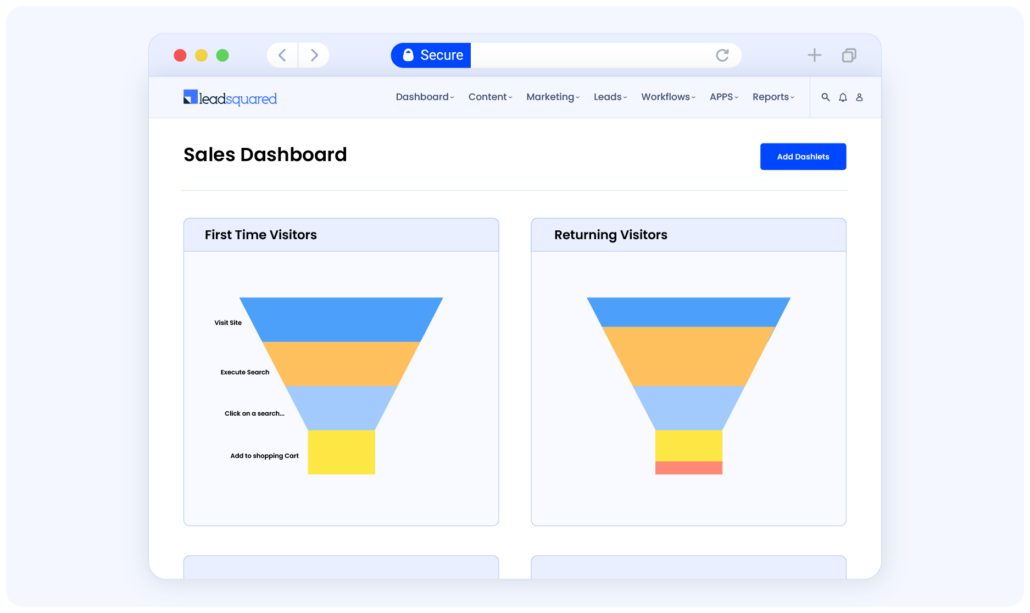
Then, note what you can do to improve vulnerabilities and double up on what’s working.
For instance, you might notice that your holiday campaigns convert best with hashtag contests. Or, you might notice that productivity ebooks work better as lead magnets than productivity checklists.
Consistently track insights like these so you can continue improving your funnel.
2. Set goals for your updated funnel
Review your current conversion rate and set new goals for your optimized funnel.
What do you hope your refined funnel will do, specifically?
Here are some examples:
- “Increase time tracking tool enterprise subscribers by 25%”
- “Attract 1,000 B2B startup founders in the EdTech space”
- “Boost metalworking and power tools sales by 15%”
3. Refine your buyer personas with updated data
Dig deeper into your ideal customer’s pain points and core needs. What new patterns do you notice when tracking their preferences and buying habits?
Shane Barker perfectly explains: “The key to maintaining a genuine connection with your audience is not just understanding who they are today, but continuously refining that understanding. Regularly updating your buyer personas with fresh data ensures you’re always in tune and never left behind.”
Grab essential data from your cloud data platform, Google Analytics, social media analytics, and your CRM.
Use these new insights to refine your buyer personas. Make sure to keep your personas top-of-mind as you move through the rest of these steps.
4. Monitor and capitalize on high-conversion traffic sources
Filter through your data one more time to reveal your high-conversion traffic sources.
I.e., if most of your qualified leads are pouring in from LinkedIn, dump more marketing eggs in that basket. If search engine optimization (SEO) is bringing in aligned website leads, scale your SEO efforts.
Consider parting ways with channels that prove to be a burden on company time with little to no sales results.
5. Solve audience pain points with valuable content
Help your audience make informed decisions by providing plenty of educational content.
How? Turn FAQs into pillar pages and topic clusters on your website. You can also repurpose snippets from these to use in email campaigns, ads, and social media content.
Here’s an example of a blog pillar page by Remote, an international HR platform:
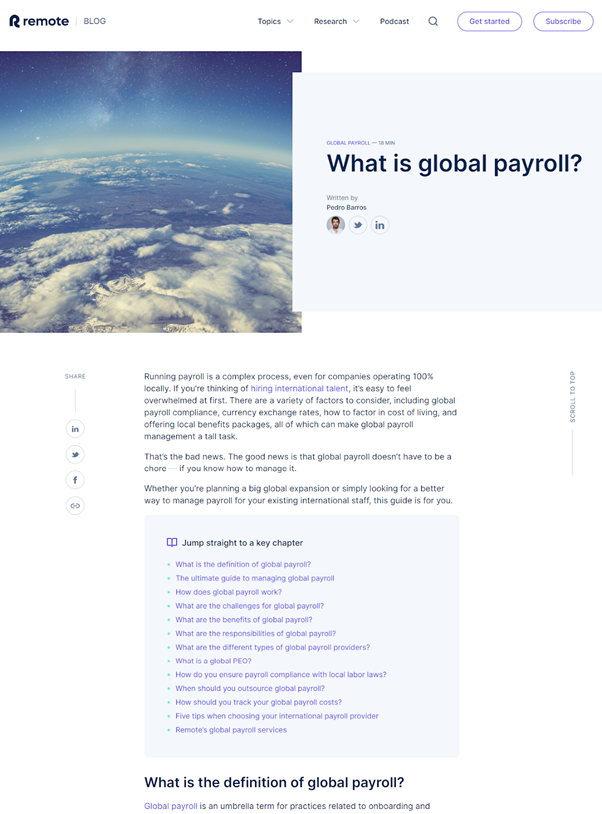
In this example, Remote answers one of its audience’s top questions: “What is global payroll?”
By going into depth with its answer, Remote:
- Satisfies search intent
- Helps its audience gain clarity on a topic they care about
- Proves its authority in the international HR space
Over time, creating blog posts like these helps Remote build its domain authority and subject-matter expertise. That means more potential to rank higher and more eyes on its products.
This is also a critical way Remote supports leads in both the awareness phase and the interest stage.
6. Grab qualified leads with irresistible lead magnets
Lead magnet campaigns give you the opportunity to collect prospect names, email addresses, and phone numbers. They also give prospects freebies they care about, which can foster more trust and interest in your business.
Your best bet?
Use freebies and gated content that new customers expressed interest in, when they were still prospects.
That might mean specific:
- Gated videos
- Webinar invitations
- In-depth guides
- Ebooks
- Promos, deals, and coupons
- Free samples
- Product guides
- Case studies
- White papers
You can also use viewing activity and other behavior data to retarget your leads.
With retargeting campaigns, you can contact prospects by email or on your website when they return.
LeadSquared helps you use push notifications, SMS campaigns, phone calls, social media, and email to engage leads.
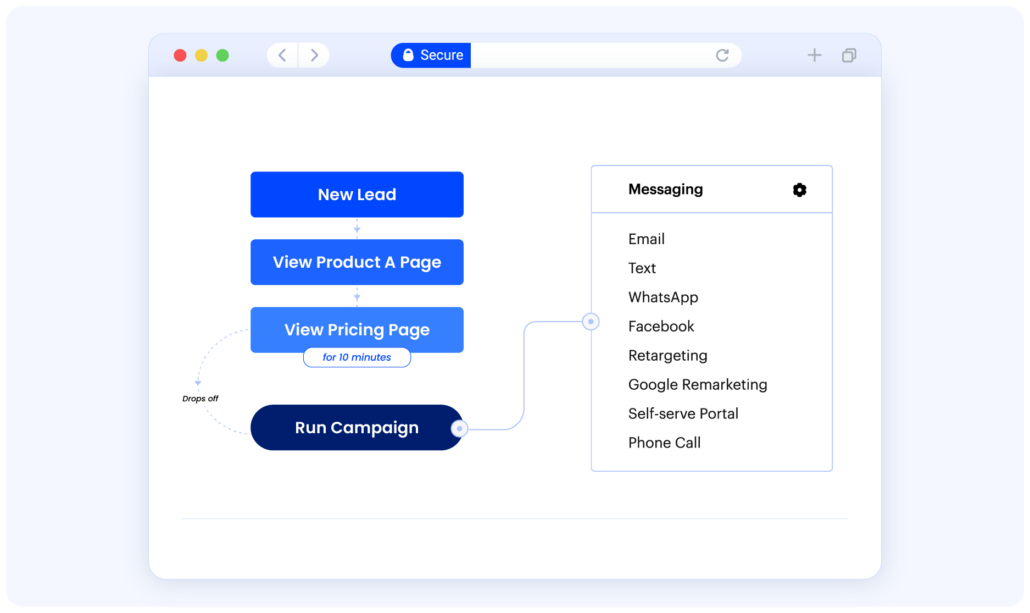
For instance, you might send a retargeting email with the following copy:
Hi Shannon,
We noticed you viewed our courses on agriculture and survivalism, but you didn’t make a purchase!
Here’s a coupon for 15% off the course of your choice — plus waived admission fees!
Or, you might send a retargeting text message like:
Did you miss our last productivity webinar, Matt? We have another one with your name on it! Sign up and get our bonus case study freebie as a gift!
Want more inspiration?
Here’s a real retargeting example from ThoughtSpot, a cloud analytics company:
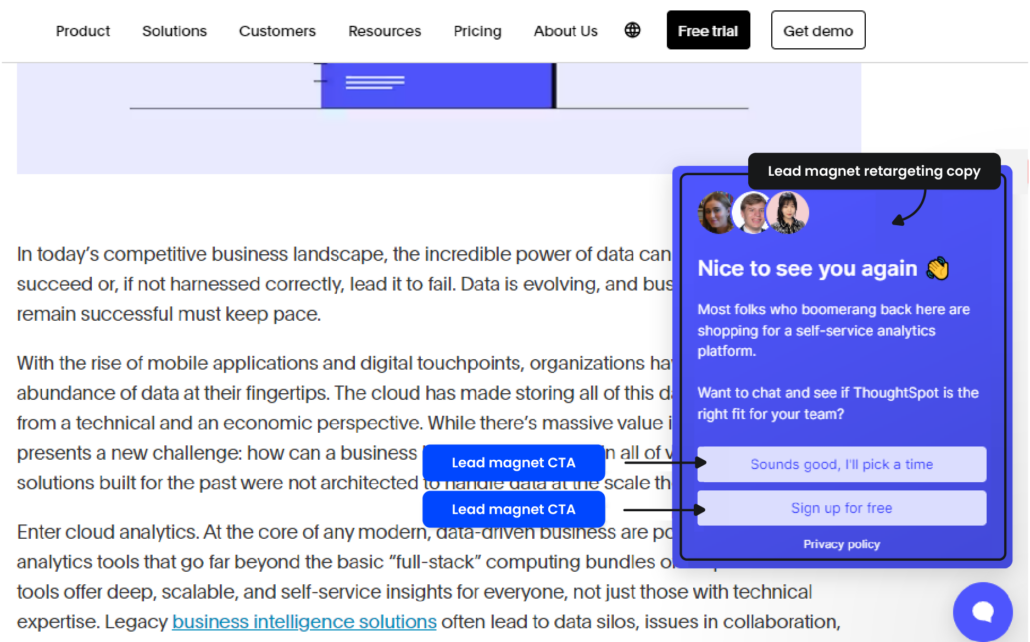
As you can see in this example, ThoughtSpot is retargeting a prospect who’s read the above blog post before — but never converted. To nudge the lead to conversion, it provides a demo call to action (CTA) button and a signup CTA button.
If the prospective customer chooses the first option, they’ll see the following capture field next:
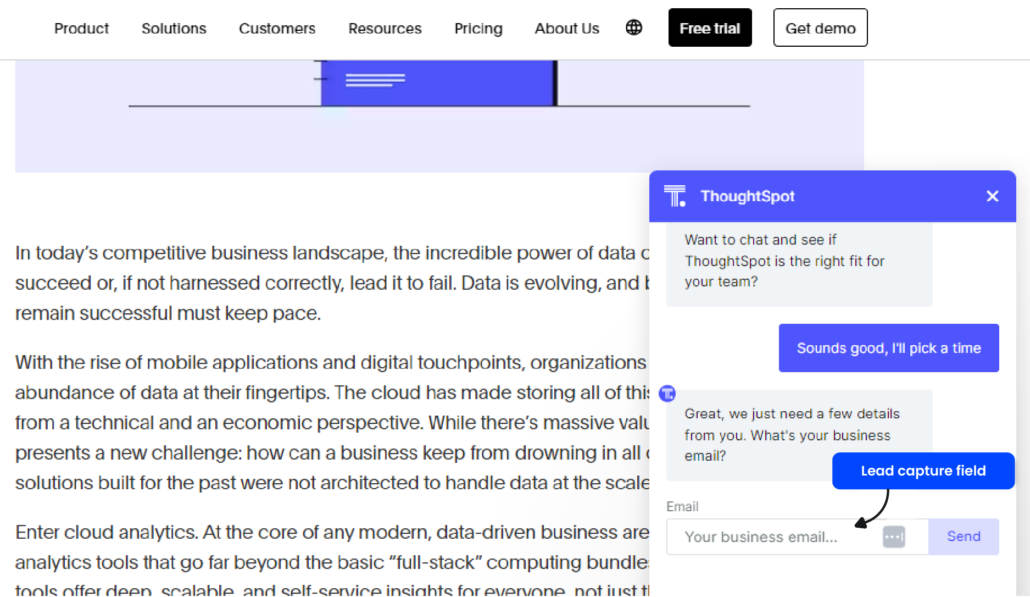
7. Optimize your landing pages, opt-in forms, and CTA buttons
Use automated split-testing campaigns to improve your landing pages, opt-in forms, and CTA buttons.
Split tests or A/B tests can help you pinpoint which exact variables in your campaigns attract the most “bites”.
For example, you might learn that your landing pages convert best when you add explainer videos. Or, you may discover that leads hand over contact info when you have at least three CTA buttons on your landing pages.
Beyond testing, be sure to integrate trust elements and social proof.
Trust elements may include:
- Stats proving your solutions work
- Big-name companies you’ve helped succeed
Social proof elements may include:
- Brand mentions
- Ratings
- Customer testimonials
Before finalizing everything, make sure your pages, forms, and buttons load quickly. You also need to make sure they’re completely glitch-free and friction-free.
Your best bet? Keep everything on one landing page and stick to three fields per form, max.
To see all these principles in action, take a peek at this landing page about how to start a business with Tailor Brands.
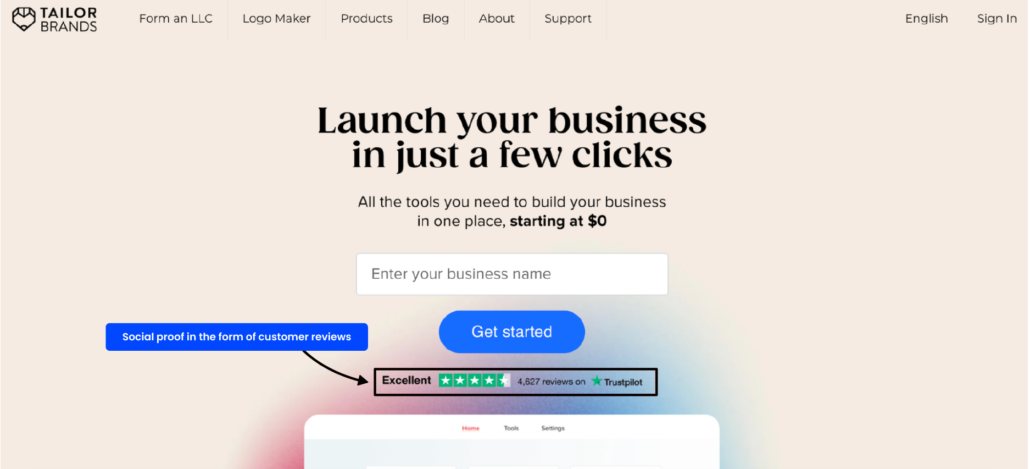
They skillfully weave in customer reviews from the reputable third-party platform, Trustpilot. With over 4,600 customers vouching for their excellence, it’s clear they’ve garnered genuine trust.
Additionally, their prominent call-to-action effortlessly guides visitors to a user-friendly form — all it asks for is a business name. The result? The path to conversion is as smooth and intuitive as possible.
8. Turn leads into customers with automated lead nurturing campaigns
Use marketing automation software to set up lead nurturing campaigns for the new contacts you’ve added to your list.
It’s also important to identify the customer segments you’re nurturing within your audience. This is pivotal to tailoring your offers to each group with segmented campaigns.
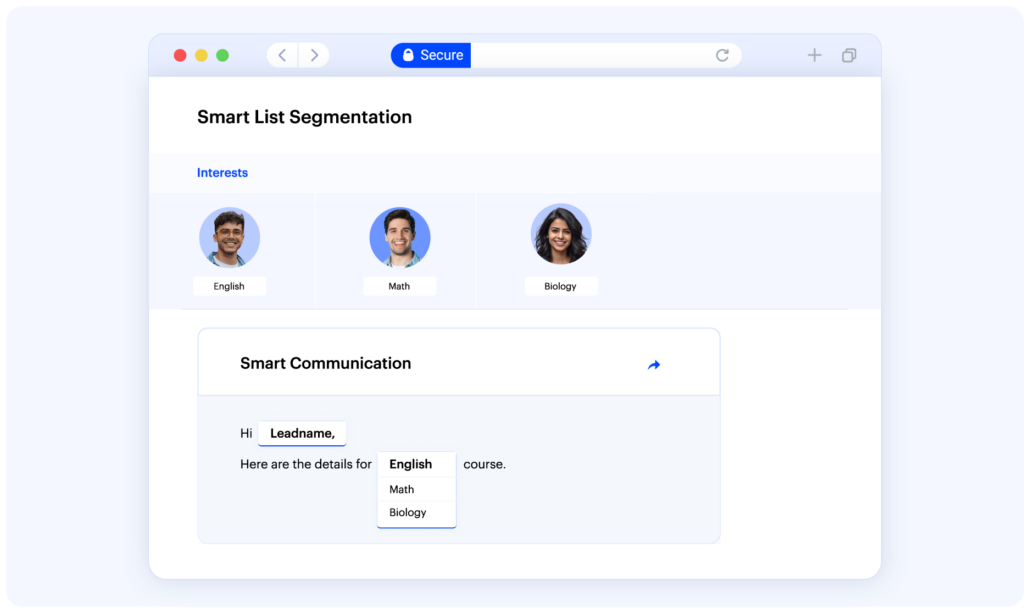
When a lead is ready to convert, make sure the checkout process is over-simplified.
This is crucial to not missing out on easy sales in the action stage!
If a customer is ready to buy, make it as easy as possible for them with:
- A fast, one-page checkout
- A guest checkout option
- Multiple payment options
- Pay-later options, if possible
Implementing a robust customer data platform can significantly enhance sales funnel optimization by enabling personalized interactions and targeted strategies at every stage.
Again, make sure your checkout page is completely friction-free. It should load quickly, be free of glitches and bugs, and provide post-purchase details immediately after the customer buys something. Be sure to also send a thank you email!
9. Nurture customer loyalty and engagement
Even when a sales funnel has been “completed”, the customer journey doesn’t end with the sale.
The true goal is to keep the journey going for as long as possible and increase customer lifetime value (CLTV). That means moving your new customers into delight, loyalty, and advocacy with a brand-new sales funnel.
Your next funnel should:
- Delight your new customers
- Foster customer loyalty
- Encourage customer advocacy
You can satisfy this by:
- Making sure your new customers are happy with your product/service
- Providing quality and timely customer support
- Offering incentives to write reviews or rate your business
- Inviting customers to join your referral, VIP, and loyalty programs
- Sending tailored offers and promos when relevant
Continue remaining on the top of their mind with ongoing email newsletters and social media content tailored to customer preferences.
Wrap up
And there you have it!
Today, we discussed what a sales funnel is, the four stages that drive it, and how to improve yours.
Remember, to optimize your sales funnel, be sure to:
- Audit your current funnel
- Set goals for your updated funnel
- Refine your buyer personas with updated data
- Monitor and capitalize on high-conversion traffic sources
- Solve audience pain points with valuable content
- Grab qualified leads with irresistible lead magnets
- Optimize your landing pages, opt-in forms, and CTA buttons
- Turn leads into customers with automated lead nurturing campaigns
- Nurture customer loyalty and engagement
Even with all the sales funnel optimization strategies in place, quantifiable results can only be achieved with a CRM for sales funnel management. It’s especially true for businesses with a large lead volume, otherwise a good chunk of leads go unaddressed and can easily slip through the funnel.
LeadSquared is an end-to-end sales automation CRM that provides complete visibility into the sales funnel and lead stages. Whether you run a call-center, digital sales, or feet-on-street teams, the tool can help you manage your sales teams effectively. Drive higher productivity and discover how to increase your sales funnel quality by 50%. Get in touch with us today!
FAQs
1. Are there any sales funnel optimization tools I can use?
Yes! There are plenty of form builders, landing page builders, and other tools you can use to optimize your sales funnel. But, they might fragment your processes and a complete end-to-end solution such as LeadSquared CRM may be your best bet. To determine the tools you’ll need, first outline your sales process. Then, research sales funnel software options designed for your specific niche.
2. What is sales funnel software?
Sales funnel software can help you set up omnichannel communication, landing pages, and lead capture forms so you can turn prospects into customers. You can also use sales funnel software to set up automated email marketing campaigns tailored to each customer segment.
3. Can I use sales funnel templates?
Yes! Some sales funnel software options offer responsive templates you can use.
For instance, with LeadSquared, you can find ready-to-use templates based on your industry and campaign type. You can also capture leads from your marketing channels and set up auto-responders until your agents can call them.





